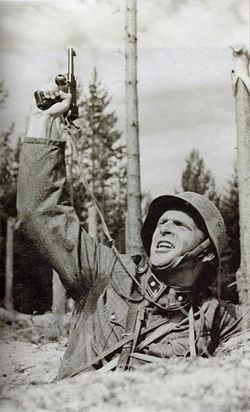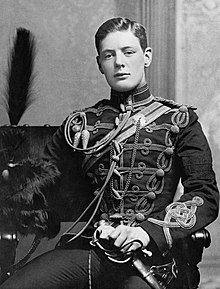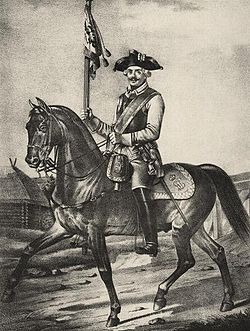In the German Landsknecht armies, recorded from ca. 1480, the equivalent rank of a Cornet existed. The cornet carried the troop standard, known as a "cornet".
---------------------
Cornet was originally the third and lowest grade of commissioned officer in a British cavalry troop, after captain and lieutenant.
Cornet Winston Churchill, while serving as a cornet in the 4th Queen's Own Hussars (1895). Churchill's formal rank was second lieutenant
It was abolished in the Cardwell Reforms of 1871 and replaced by sub-lieutenant. It is equivalent to a modern second lieutenant. The term today is restricted to internal regimental use when referring to a Second Lieutenant in the Blues and Royals and Queen's Royal Hussars.
---------------------
 This rank was also used in other countries, eg, in the Russian Empire, and the Prussian cavalry, before 1870.
This rank was also used in other countries, eg, in the Russian Empire, and the Prussian cavalry, before 1870.The rank also exists in a few other European military organizations, often with historical ties to the German system. Examples are the Netherlands, Sweden, Norway, and Finland (see Fänrik). The French Army has a similar position called an Aspirant .
In the Finnish landforces and airforce, Vänrikki (Fenrik) is the lowest commissioned officer rank, which is granted to the soldiers in the national service on the day they are released from their 347-day service.


Finnish Vänrikki are thus of equal rank to the German lieutenant (also a platoon leader), also second lieutnant, or an officer aspirant (French, Aspirant).
Vänrikki Korhonen leads, and soon long patrol mens moves behind of enemy lines...
---------------------------------



Fähnrich, short Fhr, is the lowest rank of the commissioned officers CO rank group (also rank group: Officers) in the Austrian Bundesheer.
Austria-Hungaria (until 1918)


Fähnrich was the lowest officer rank in the kuk Common Army. In 1838 it was renamed to Unterleutnant 2. Gebürnisklasse, from 1849 to Unterleutnant 2. Klasse, since 1868 to Unterleutnant, and finally approximately from 1868 to Leutnant . In 1908 Fähnrich was re-introduced as lowest cadet-officer rank in order to replace the 1869 rank designation Kadett-Offiziersstellvertreter. Fähnrich, Kadett-Offiziersstellvertreter respectively completed training and education on the less famous so-called kuk Kadettenschule.
As the Kadett-Offiziersstellvertreter was the highest NCO-rank, became Fähnrich a separate rank-class. However, graduates from the much more famous Militärakademie became the officer patent for Leutnant.
------------------




In the ku Royal Hungarian Honvéd army Zászlós was the equivalent to the Fähnrich rank. It accounted immediately to the officer corps.
Cornet was originally the third and lowest grade of commissioned officer in a British cavalry troop, after captain and lieutenant .
It was abolished in the Cardwell Reforms of 1871 and replaced by sub-lieutenant . It is equivalent to a modern second lieutenant . The term today is restricted to internal regimental use when referring to a Second Lieutenant in the Blues and Royals and Queen's Royal Hussars.
 This rank was also used in other countries, eg, in the Russian Empire , and the Prussian cavalry, before 1870.
This rank was also used in other countries, eg, in the Russian Empire , and the Prussian cavalry, before 1870.Winston Churchill while serving as a cornet in the 4th Queen's Own Hussars (1895). Churchill's formal rank was second lieutenant.
Cornet was originally the third and lowest grade of commissioned officer in a British cavalry troop, after captain and lieutenant.
Cornet Winston Churchill, while serving as a cornet in the 4th Queen's Own Hussars (1895). Churchill's formal rank was second lieutenant

It was abolished in the Cardwell Reforms of 1871 and replaced by sub-lieutenant.
It is equivalent to a modern second lieutenant. The term today is restricted to internal regimental use when referring to a Second Lieutenant in the Blues and Royals and Queen's Royal Hussars.
This rank was also used in other countries, eg, in the Russian Empire, and the Prussian cavalry, before 1870.
The rank was in use by the time of the English Civil War. Among famous cornets in that conflict were George Joyce, Robert Stetson, and Ninian Beall.
ECW cornets >>>>
It was abolished along with the purchase of commissions in the Army Reform Act of 1871, replaced by second lieutenant.
The ranks of ensign and cornet were abolished in the US Army in 1815.

The rank also existed in other nation's cavalry troops, such as those of Sweden (kornett) and Imperial Russia (корнет), and by the Continental Army in the American War of Independence. General Alexander Macomb was initially commissioned a cornet in a career in which he eventually became Commanding General of the United States Army. It is still used in the artillery and cavalry divisions of the Netherlands (kornet).
Russian Cornet.
 The rank of field cornet (veldkornet) was used for the senior officer of a ward or sub-district in the independent republican states of the Transvaal and Oranje-Vrystaat in late 19th century South Africa. They were elected by the commandos of their ward for periods of three years. In the case of large wards, an assistant field cornet could also be chosen. The rank was reminiscent of the Dutch use in cavalry troops that the commandos most closely resembled. In apartheid-era South Africa, the rank of field cornet was used in the South African Army from 1960 to 1968.
The rank of field cornet (veldkornet) was used for the senior officer of a ward or sub-district in the independent republican states of the Transvaal and Oranje-Vrystaat in late 19th century South Africa. They were elected by the commandos of their ward for periods of three years. In the case of large wards, an assistant field cornet could also be chosen. The rank was reminiscent of the Dutch use in cavalry troops that the commandos most closely resembled. In apartheid-era South Africa, the rank of field cornet was used in the South African Army from 1960 to 1968.Traditional duties
The subaltern rank of cornet was the equivalent of the contemporary infantry rank of ensign, today's second lieutenant in each. The cornet carried the troop standard , known as a "guidon".
Ei kommentteja:
Lähetä kommentti
Any explosive ammunition or empty cores, you can put in this.